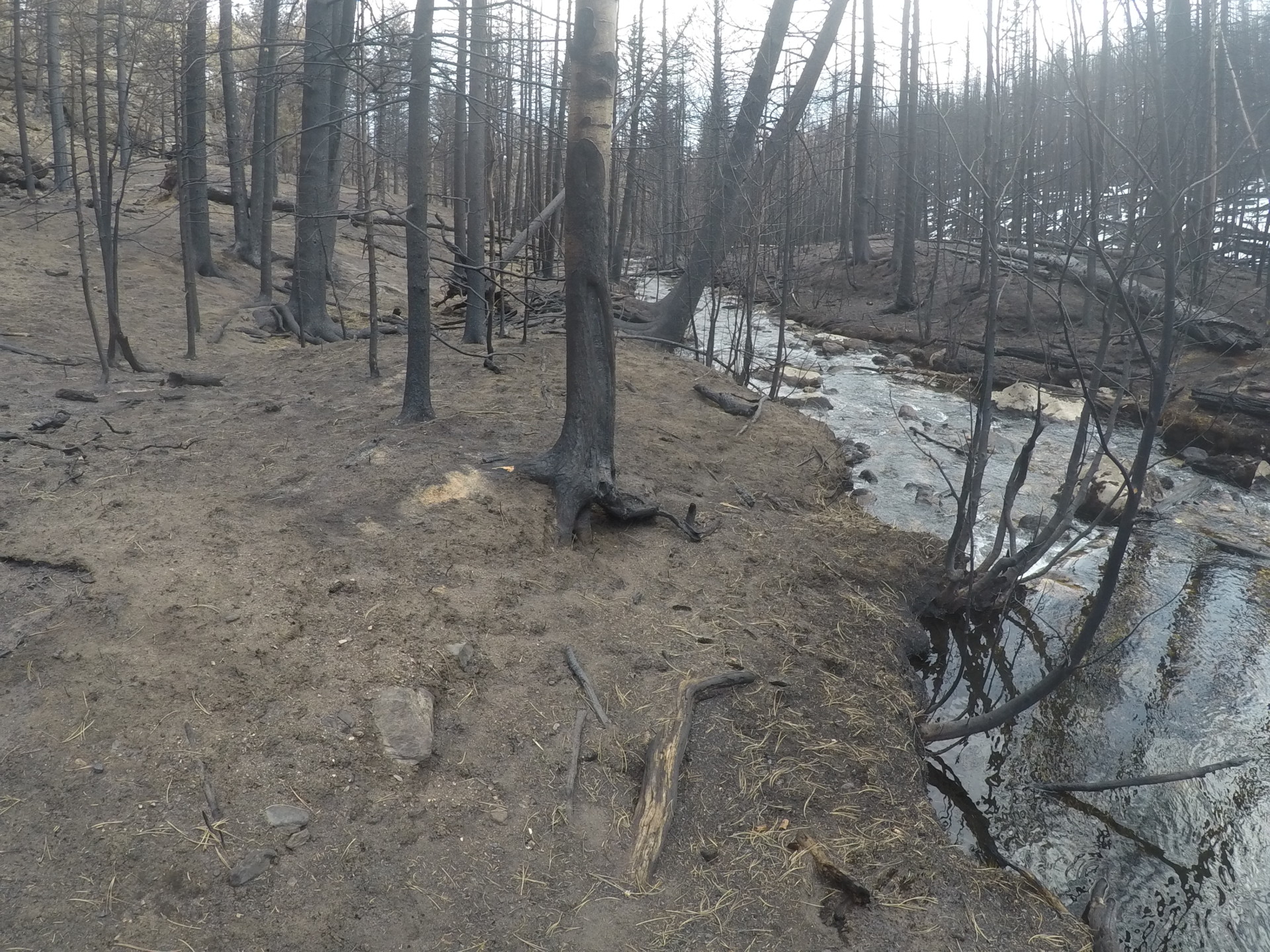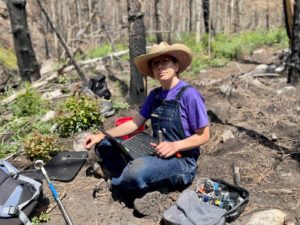
CSU’s Ellen Wohl began research at Little Beaver Creek in 2013, studying logjams and how they span stream channels. This photo was taken by Wohl on her first visit to the creek in Nov. 2020, following the Cameron Peak Fire.
Colorado State University Professor Stephanie Kampf said it was an emotional experience when she returned to her research sites in the Poudre Canyon in November 2020 after the Cameron Peak Fire. Kampf and her team had been monitoring streams and rivers prior to the fire, and nearly all the research equipment had been destroyed.
A lone sensor in a stream survived. “It was in the water, which helped it from getting destroyed,” she said.
With an award from the National Science Foundation and funds from CSU’s Office of the Vice President for Research, Kampf and her team purchased new equipment and continued to study snowpack, streams and sediment in waterways in areas affected by the largest wildfire in Colorado history.
On a recent visit to a site near Rustic, Colorado, Kampf and Francis Rengers — a CSU alum, research partner and geologist with the U.S Geological Survey — were pleased with the vegetation growth they saw.
“The ground recovery is great,” said Kampf. “But it’s not like this everywhere.”
Monitoring weather, floods, debris flows

The research team has set up a weather station that measures rainfall, humidity, radiation, wind and temperature. They’ve also placed sensors in the water to calculate flow rate in the waterways and monitor how the stream channels are changing due to snow melt and rainfall.
“We’re interested in how much rain is falling, how quickly it falls and determining which rains cause flash floods and debris flows,” Kampf said.
The rush of water from flash floods in the canyon increased in July, causing local agencies to issue alerts to people driving in the area to turn around and head home, away from the canyon.
Kampf said this type of flooding can lead to property and road damage. It has even led to loss of life. On July 21, the Larimer County Sheriff closed a portion of the canyon due to flooding and mudslides into the Poudre River. Three people have been confirmed dead and one was still missing.
The research team has found that in lower and upper elevation areas, soils aren’t soaking up as much of the snow melt as in other years, which leads to more water in the rivers.
Kampf said she expects to see the effects of the Cameron Peak Fire over the next three years. And what if another fire hits the canyon this summer?
“Forests burn, it’s part of their life cycle,” she said. “We don’t wish for them to burn. It affects people’s lives, and we have the after-effects to deal with. We need to be prepared for them – and new extremes we haven’t seen before – so that we can minimize the damage.”
A skeleton of a forest
Not far from where Kampf was working, University Distinguished Professor Ellen Wohl is conducting research on Little Beaver Creek near CSU’s Mountain Campus. Her main goal is to measure how effectively logjams reduce downstream pulses of sediment.
Wohl began research at the creek in 2013, studying logjams and how they span channels, which sometimes leads to the creation of a pool that stores a lot of fine sediment and other organic matter.
Underneath the channel lies a hyporheic zone, which she said is sometimes called the river’s “liver.”
“It should be called a kidney, since it removes nitrate from the water,” Wohl said.
Layers of life keep rivers healthy

The microbes and insects in this zone under the channel work as cleaning agents. The water that returns to the channel also tends to be cool, helping to keep stream temperatures low, which is good for trout and salmon.
Wohl said she was “desperate” to get to Little Beaver Creek after the Cameron Peak Fire. She went up three times in November 2020 before getting shut out by ice and snow. Since April 2021, she has visited the creek at least once a week.
“When I saw the watershed for the first time in November, it was amazing,” she said. “It was shocking emotionally but amazing scientifically.”
Wohl said it was akin to seeing a skeleton of the forest.
“We have somewhat open forests but there’s usually a canopy,” she explained. “It burned very intensely, and, on the surface, it looked like standing charcoal sticks. I saw a lot of features I’d never seen before. The fire was so intense that a lot of the logjams had become long pieces of charcoal.”
The loss of logjams means that when it rains or during snowmelt, there’s a big pulse of sediment released into the waterway. This can be stressful for aquatic organisms, including mayflies, caddisflies and even tiny clams found in the creek.
Wohl’s research is currently unfunded, but she said she couldn’t pass up studying the after-effects from the massive fire.
“This is a unique opportunity, particularly because I’ve been working in these areas for years,” she said. “I’m roping in everyone else I can to help.”
Kampf’s NSF-funded research team includes Paul Evangelista and Tony Vorster (Natural Resource Ecology Lab), Sean Gallen, Dan McGrath, Sara Rathburn and Ellen Wohl (Department of Geosciences), Ryan Morrison and Peter Nelson (Department of Civil and Environmental Engineering), Steven Fassnacht (Department of Ecosystem Science and Sustainability) and Kristen Rasmussen (Department of Atmospheric Science).